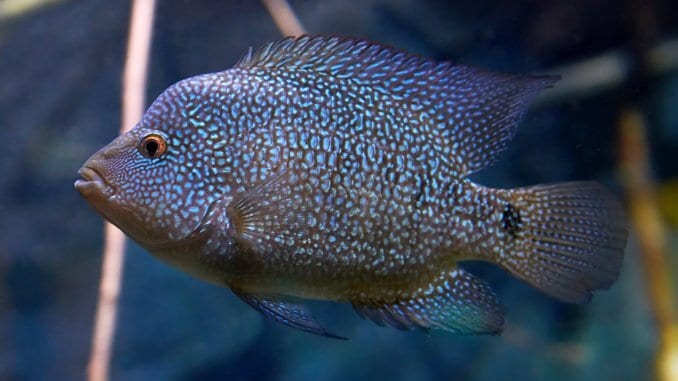
Cichlids have become very popular – they are beautiful, big, intelligent, and exotic.
However, there are so many species that it is easy to get confused.
We are here to introduce you to one of the most beautiful members of the group, the Texas cichlid.
This magnificent fish is a great way to diversify your collection. Their behavior is truly unmatched and they will keep you entertained for a long time.
TABLE OF CONTENTS
Texas Cichlid Facts & Overview
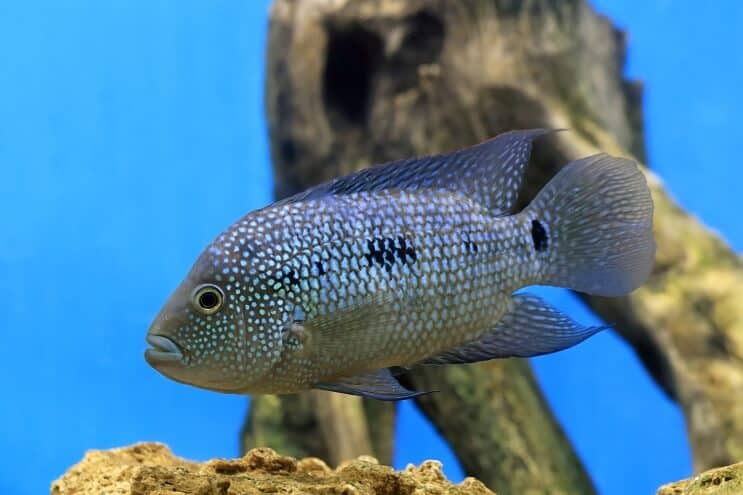
| Category | Rating |
| Care Level: | Intermediate |
| Temperament: | Aggressive |
| Color Form: | Light blue |
| Lifespan: | 13 years |
| Size: | Up to 12 inches |
| Diet: | Omnivore |
| Family: | Cichlidae |
| Minimum Tank Size: | 55 gallons |
| Tank Set-Up: | Freshwater, spacious, few sturdy plants |
| Compatibility: | Limited |
In recent years Cichlids have become enormously popular with fish keepers all over the world.
The Texas Cichlid (Herichthys cyanoguttatus), is a member of the well-known Cichlidae family – in good aquarium conditions they can live for up to 13 years.
In addition to their impressive lifespan, they are also very big, growing up to 12 inches in length.
Although they might not be the first species of Cichlid that comes to mind, they are still widely available. You can find them in most pet stores and they should not cost you more than $35.
They have become invasive species in multiple regions due to their dominant and aggressive temperament. This might be good for them but it is extremely harmful to other fish in the same ecosystem.
Unfortunately, this behavior also transfers to the tank. However, with the correct knowledge and care, you will be able to look after them.
Typical Behavior
These species share a lot of similarities with other Cichlids – the most obvious one is their aggressive, territorial behavior.
They are not schooling fish and will not get along with each other, let alone other species.
When it comes to which level of the tank they inhabit, they don’t have any particular preference.
They do like to dig in the substrate, move the gravel around and sometimes shred plants. Also, you won’t find them hiding much, they like to be active and out swimming.
Texas Cichlid is extremely intelligent and appear to know their owners. They will push up to the front of the tank if they know it’s feeding time, almost to interact with their owner.
Appearance
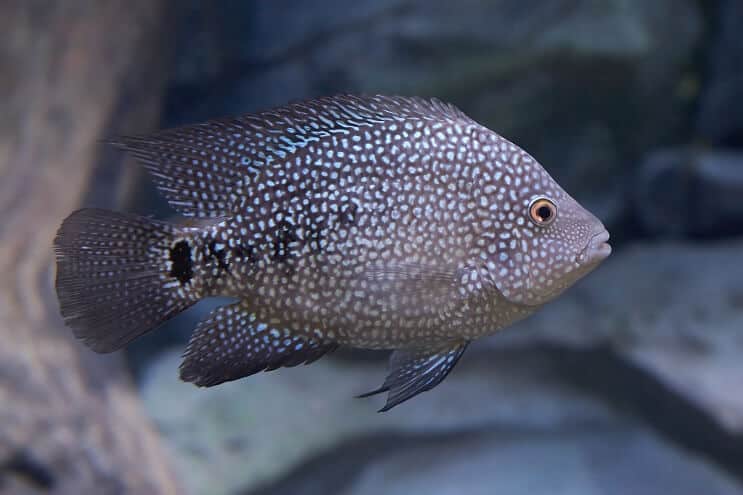
These fish are loved for their beautiful appearance – their coloration instantly turns your tank into a neon glowing masterpiece.
Although there is some variation, usually Texas Cichlid has an unusual dotted pattern. It consists of differently sized spots that usually vary in color from green to light blue. The body itself will often be dark or light green.
They look amazing when the light hits their fins. They are very thin and scatter the light so that it looks like they have been lit up. The dots on their body will also glow under light.
There are also various color gradients that you will notice on their body. Closer to their abdomen, the primary green color transitions into a much darker tone.
As for their shape, it is the well-recognized Cichlid silhouette.
Their body starts off with a gently curved fin base and gradually forms a slope, where their robust fins sit. You will also notice a slight hump on the top of their head.
Habitat and Tank Conditions
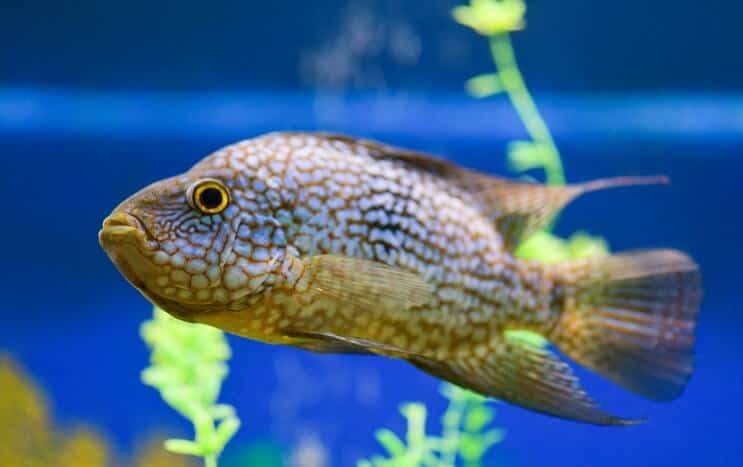
These fish are the only Cichlids that are naturally found in the United States.
They are found in a part of the Rio Grande River which flows across Texas and North Mexico. This is why they are commonly known as either Texas or Rio Grande Cichlids.
Despite being native to the area, they can be found in neighboring smaller lakes, ponds, and tributaries. This small region combines everything a large fish like this would require. The flow in these places is fast and the water is warm.
The substrate mainly consists of sand combined with pebbles. There are some occasional plants and rocks scattered around the bottom.
Tank Setup
It is not difficult to recreate their natural environment in your tank.
Their preferred temperature is in the range of 71.5°F-77°F, so most tanks will require a heater. The pH should be kept in the range of 6.5-8 and the water hardness should be between 8-15 dGH. It is important to create a moderate flow in the tank also.
Another important aspect of their setup is the substrate. In their natural habitat, it is mainly made up of sand but they can also live in a tank with very fine gravel. However, if you want to keep it as natural as possible consider using a mix of both.
The tank should have lots of open space to swim however you can place some plants sparingly. From time to time they might still use them as hiding spots, especially if you are keeping juveniles.
Although they look very bulky, they are quite agile and can easily jump out of the tank. This rarely happens, but you might want to have a lid on top just in case.
What Size Aquarium Do They Need?
A Texas Cichlid needs at least a 55 gallon tank, but the larger the better.
If you want to keep them in pairs, a minimum volume of 110 gallons is needed.
Tank Mates
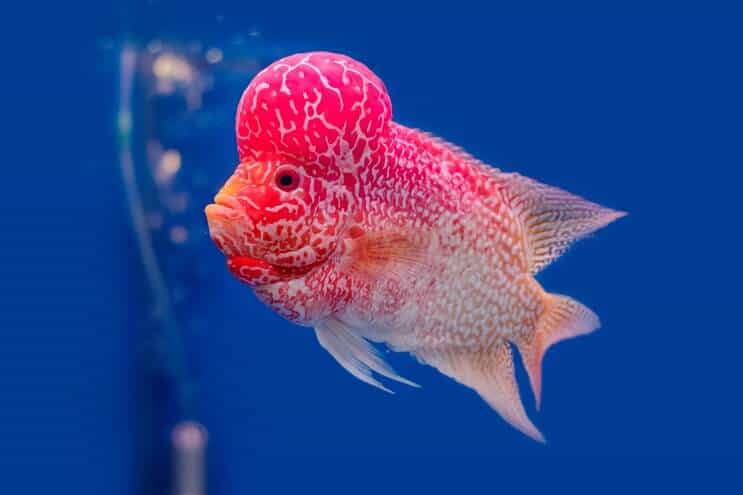
Unfortunately, their unwelcoming attitude makes them an unlikely choice for a community tank.
In the wild they usually lead a solitary lifestyle, only finding pairs for the breeding period. There are some exceptions though, such as younger individuals.
Their friendliness mainly depends on how large their tank is.
This means that in some cases they might be able to live alongside other species. But usually, they will need to be kept separately. If you want to try keeping them in the same tank with other species, you will need to start with juveniles.
The youngsters should be kept with other non-aggressive fish. However, when these Cichlids grow up their behavior quickly changes. They become very aggressive, picking on almost any other fish.
If you don’t have an option to keep them separately, you might try placing them in the same tank with Giant Gouramis, Plecos, Tambaqui, Eels, other Catfish, or even Knifefish.
Keeping Texas Cichlids Together
Texas Cichlid should really be kept alone due to their aggression.
They can be kept together but it is very tricky. You would need to have a very large tank (110+ gallons) to allow them both to establish their own territories.
Texas Cichlid Care
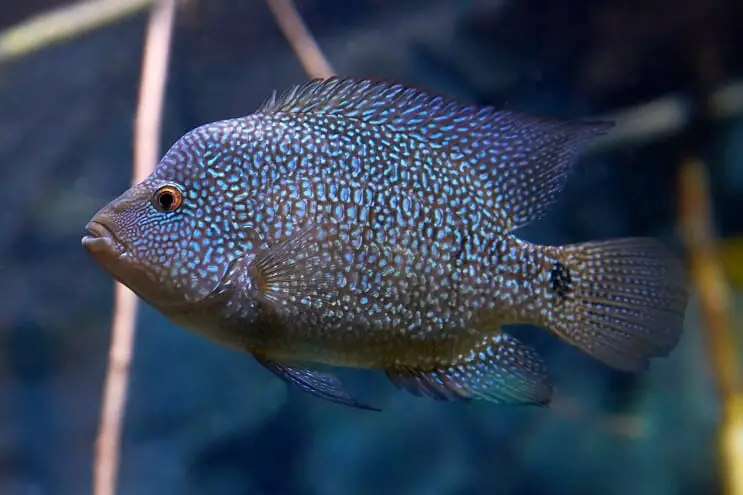
Obesity with Texas Cichlid is a big problem.
It is closely related to overfeeding and can lead to deterioration of organ function and behavioral changes. It is very important to monitor what your fish eats.
To avoid overeating simply keep the portion size the same, it should be about 10% of the total weight of the fish.
It is also very important to pay attention to the quality of the water in the tank. Make sure that you perform regular water renewals to maintain a healthy environment. Renewals help avoid stale water in the tank, and also oxygenate and enrich the water with nutrients.
In the wild, physical processes take care of mixing up the water column. In the tank, you recreate this process through regular water changes. Make sure to do this regularly if you want to maintain a comfortable environment for the fish.
The Texas Cichlid is a sturdy species that is not prone to any particular disease. But there are some common diseases that no fish is immune from – one of them is fin rot. This happens when the fish damages their skin. If the cut is deep enough, it will penetrate the scales and can cause infection.
To avoid this try making sure that the substrate in your tank is always nicely filtered with no sharp edges sticking out of the bottom. Also, make sure to regularly trim the plants if you have species with hard stems.
Diet
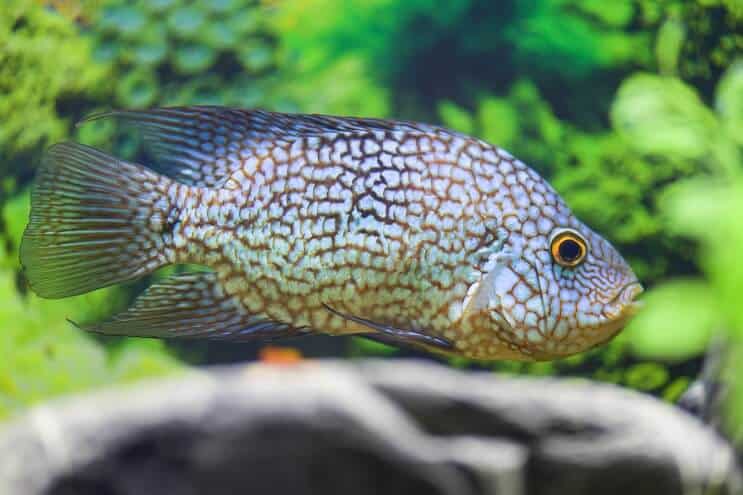
These fish are omnivores with a huge appetite and will gladly feed on almost anything. In the tank, they can be fed all sorts of foods ranging from frozen to live to plant-based.
To make sure that your fish stays healthy try to diversify their diet as much as possible.
You might consider feeding bloodworms, frozen shrimp, crustaceans, artificial and live foods. You can also try adding plant-based flakes from time to time to keep things fresh.
These fish are very sturdy and do not require any additional nutritional supplements. The best possible supplement is a rich and high-quality diet.
There are some restrictions that you should be aware of: avoid feeding them mammalian meat, as you can do with some other Cichlids.
These fish are also pretty messy and it is recommended to feed them small portions, two times a day.
Are Texas Cichlid Suitable For Your Aquarium?
The Texas Cichlid is a great fish for anyone looking to include a very beautiful specimen in their aquarium.
This fish is not for beginners because their personality can be rough around the edges and they require a large tank.
If you are confident in your abilities and have prior knowledge of maintaining a large tank, go ahead!
If you are feeling a bit intimidated, there are plenty of other less aggressive Cichlids that you might choose for your first fish.
Read this Article: Corner Fish Tank (Setup Ideas, Equipment, Stocking And Much More…)
Do you own one of these Cichlid? Let us know in the comments section below…

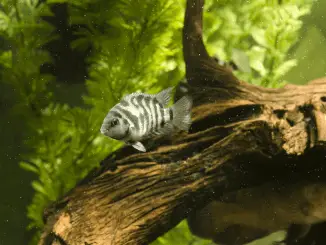
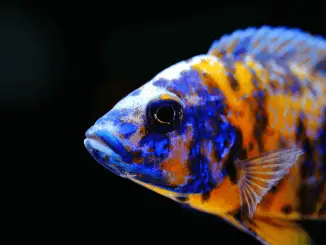
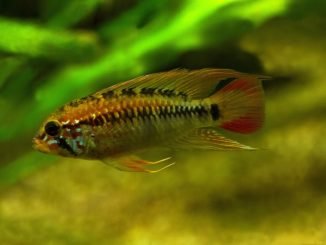
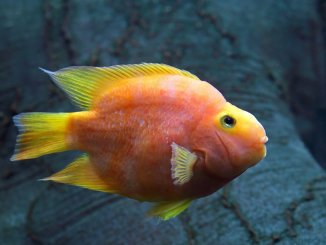
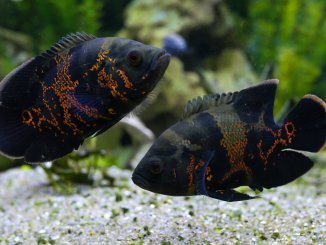
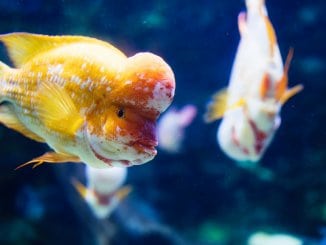
If the Texas Cichlids are happy, they will breed, even if there are other fish in the aquarium. I started with a mated pair in a community 250 gallon aquarium. Only a couple of fish from each batch of eggs will survive being eaten by the community, but I now have eight more adults. I have raised the entire batch of eggs a couple of times, but only by moving the rock the eggs are on to a separate tank. I have gotten over 70 babies from a batch.
How long does it take them to grow? Our Texas cichlids just had babies. We saved as many as we could and put them in another tank to grow without being harmed. I just wanna know how long until they start getting bigger? We just discovered the babies yesterday.
As for me I will keep a male [SMALLMOUTH BASS with fry],6 big silver dollar fish, 7 big tinfoil barb fish,2 clown loach catfish and 1 single male Rio grande texas cichlid.
The male [SMALLMOUTH BASS]is KING
I’ve decided to put 3 pumpkinseed sunfish,4 firemouth cichlids,2 male clown loach catfish a male [smallmouth bass with his fry] and 1 single male Rio grande texas cichlid. No tinfoil barbfish.
I decided to get a 5″ male [SMALLMOUTH BASS] 3 pumpkinseed sunfish 2 blue botia loach catfish and 1 single 7inch male Rio grande Texas cichlid in a long long long long wide 46 gallon tank.
And I will get a separate tank and put a pair of hybrid bluegill which is a bluegill sifish/green sunfish they will be named [BIG BLUE] and [MOESHA BLUE] the tank will be a long 47gallon they will rule it and live behind nice patch of tall very wavy purpleblue plants I will add 4 firemouth cichlids 2 blue botia loach catfish and 1 single male Rio grande tx cichlid named {sheriff} he will NEVER breed the only ones breeding will be my hybrid sunfish. he will watch them always together the male tx will be users as a pawn in the hybrid sunfish pair game he will get jealous and sexual tension will build to the point he will SNAP but if he get violrent and attack Mrs BLUE BIG BLUE will kill him.
What you used for the photos are not true Texas cichlids, but are of a different Herichthys species called the Carpintis, only your first photo is somewhat of a resemblance of a Texas cichlid. Pure Texas cichlid will not have green or blue coloration but more of just a pearly appearance without much blue or green like the first photo.
I purchased an adult male and he is 12″ and is about 5 lbs. He hangs with 4 giant danios. I was told he was a hybrid. Surprise Surprise! I did some research and realized what he was. I have to be careful with tank changes. He gets quite aggressive and rams my arms. I love his beautiful colors but his attitude stinks!
Hi,my name is Lolo, and after purchasing a microscope I went to our local park which has a creek running through it. I dunked a Coffee can a couple of times and dragged it along the bottom, resulting in about half a can of muddy water and algae. Back at home while using a pipet to grab a water sample, some movement behind a twig caught my eye. Thinking maybe it was a baby tadpole, I took a closer look….and lo, and behold it was a tiny fish 🐟 about half the size of a dime.
That was two weeks ago, and after putting him or her in a 10 gallon tank I grabbed from Walmart along with a few other fish(I had gone back to the same park and purposely caught this time), he or she is now almost an inch long. Very pretty and is already practicing maneuvers the likes of which you’d only see aerobatic pilots pulling off at an airshow!! 😁.
Well, I guess I’ve decided to go all in…and give it a try. It’s a baby, and it’s a beautiful fish, but it’s growing fast and quickly developing quite the attitude 🐟😁😍😎.
Now I’ve gotta get, and set up a big tank just my Texas Cichlid 💖.
My Texas cichlid has decided to only stay at the bottom of the tank. This began about 3 days ago. Does anyone know why this would be the case? She’s approximately 8 years old. Used to always come to the top to eat but now hides constantly in her log.
I have kept several Texas Ciclids through the years. One of the most amusing things is that as they mature they make a clicking noise. It sounds like a person clucking their tongue loudly. Mostly at night. They inevitably scare themselves with the loud noise.